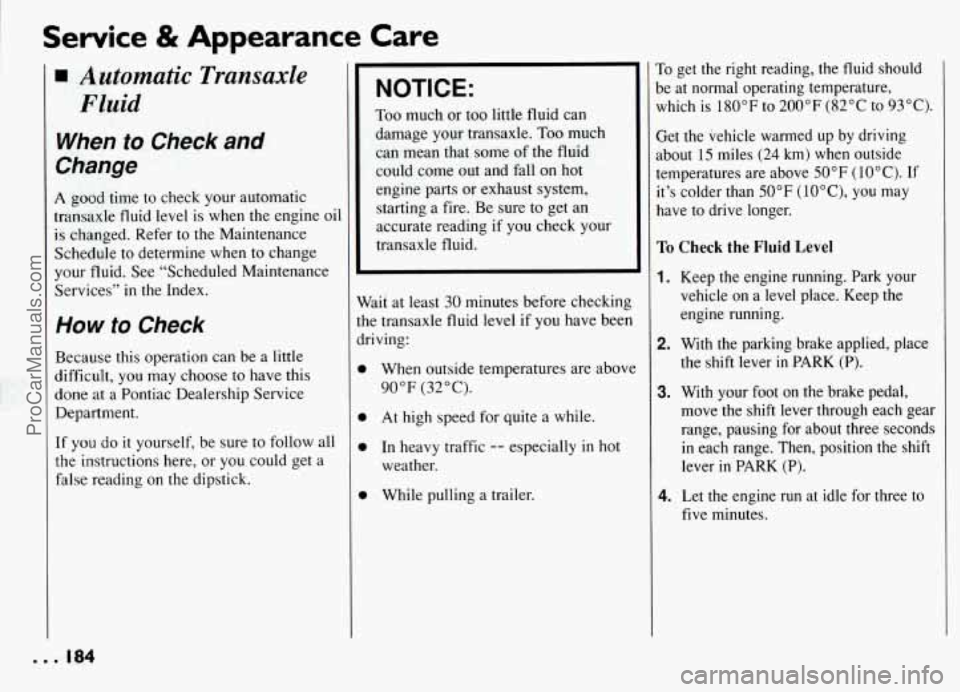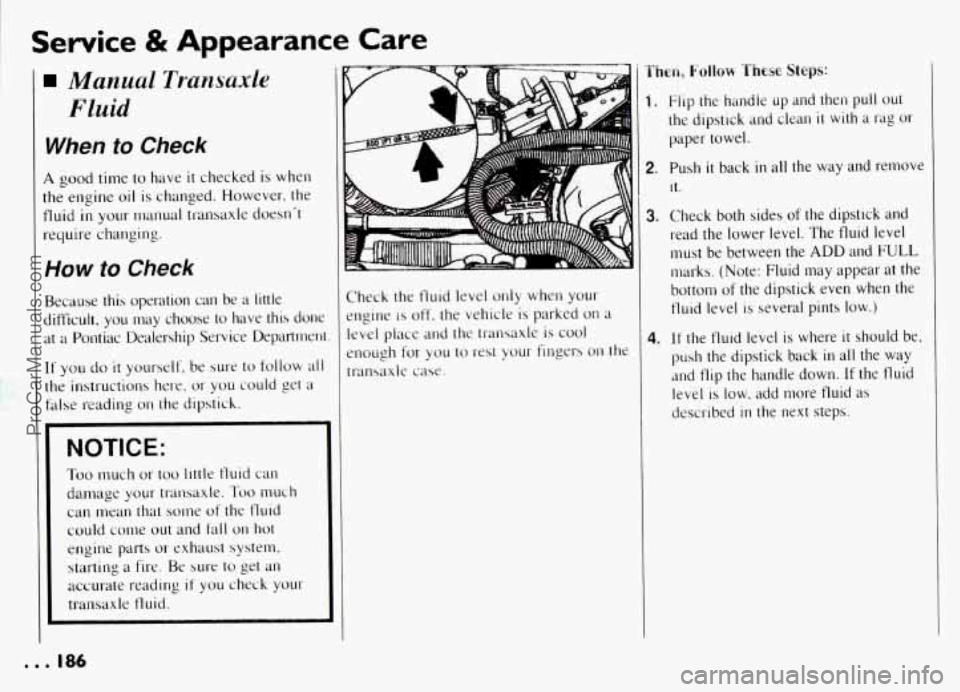Page 96 of 274

LOW
COOLANT
Low Coolant Warning
Light
F this light comes on and stays on, the
ehicle should be promptly pulled off the
Dad and the coolant level checked. See
Engine Coolant” in the Index. If there
re visible signs of steam see “Engine
herheating” in the Index before opening
le hood.
V6 Engine
Low Engine
Oil Level
Warning Light
Your vehicle may be equipped with an oil
level monitoring system. When the
ignition key is turned on, the light will
briefly flash. If the light stays on, stop the
vehicle on a level surface and turn the
engine off. Check the oil level using the
engine oil dipstick. (See the Index under
“Engine Oil.”) If the light does not flash,
have the low oil level sensor system
repaired
so it will be ready to warn you if
there’s a problem.
NOTE: The oil level monitoring system
only checks oil level during the brief
period between key on and and engine
crank.. It does not monitor engine ail level
when the engine
is running. Additionally,
an oil level check is only performed if the
engine has been turned off for a
considerable period of time allowing the
oil normally in circulation to drain back
into the oil pan.
Oiil Warning Light
If you have a problem with your oil, this
light may stay on after you start your
engine, or come on when you are driving.
This indicates that oil is not going through
your engine quickly enough to
keep it
lubricated. The engine could be low on
oil, or could have some other oil problem.
Have
it fixed right away.
The oil light could also come on in three
other situations:
0 When the ignition is on but the engine
is not running, the light will come on
as a test to show you it is working, but
the light will go out when you turn the
ignition to “Start”. If it doesn’t come
ProCarManuals.com
Page 178 of 274
2.3L Quad OHC and Quad
4 Engines (CODES 3,
D AND A)
When you open the hood, you'll see:
1. Automatic Transaxle Dipstick
(if'equipped)
2. Brake Fluid Reservoir
3. Air Cleaner
4. Hydraulic Clutch Fluid Reservoir
(if so equipped)
5. Battery
6. Windshield Washer Fluid Reservoir
7. Power Steering Fluid Reservoir
B. Engine Oil Fill Cap, Engine Oil
Dipstick
3. Engine Coolant Surge Tank
ProCarManuals.com
Page 179 of 274
Service & Appearance Care
3.IL V6 Engine (CODE M)
When you open the hood, you’ll see:
1. Power Steering Fluid Reservoir
2. Automatic Transaxle Fluid Dipstick
3. Brake Fluid Reservoir
4. Air Cleaner
5. Battery
6. Windshield Washer Fluid Reservoir
7. Engine Oil Dipstick
8. Engine Oil Fill Cap
9. Engine Coolant Surge Tank
ProCarManuals.com
Page 180 of 274

Engine Oil
If the CHECK OIL light on the
instrument panel comes on,
it means you
need to check your engine oil level right
away. For more information, see “Check
Oil Light”
in the Index. You should check
the engine
oil regularly; this is an added
reminder.
It’s a good idea to check your engine oil
every time you get fuel. In order to get an
accurate reading, the oil must be warm
and the vehicle must be on level ground.
Turn off the engine and give the oil a few
minutes to drain back into the oil pan.
If
you don’t, the oil dipstick might not show
the actual level.
To Check Engine Oil
Pull out the dipstick and clean it with a
paper towel or cloth, then push
it back in
all the way. Remove it again, keeping the
tip lower, and check the level.
When to Add Oil
If the oil is at or below the ADD line, then
you’ll need to add some oil. But
you must
use the right kind. This section explains
what kind of oil
to use. For crankcase
capacity, see “Capacities and
Specifications” in the Index.
Adding Engine Oil
Just fill it enough to put the level
somewhere
in the proper operating range.
Push the dipstick all the way back
in
when you are through.
NOTICE:
Don’t add too much oil. If your
engine has
so much oil that the oil
level gets above the cross-hatched
area that shows the proper operating
range, your engine could
be
damaged.
179. . .
ProCarManuals.com
Page 185 of 274

Service & Appearance Care
Automatic Transaxle Fluid
When to Check and
Change
A good time to check your automatic
transaxle fluid level is when the engine oil
is changed. Refer to the Maintenance
Schedule to determine when to change
your fluid. See “Scheduled Maintenance
Services” in the Index.
How to Check
Because this operation can be a little
difficult, you may choose
to have this
done at a Pontiac Dealership Service
Department.
If you do it yourself, be sure to follow all
the instructions here, or you could get a
false reading on the dipstick.
NOTICE:
Too much or too little fluid can
damage your transaxle.
Too much
can mean that some of the fluid
could come out and fall on hot
engine parts or exhaust system,
starting a fire. Be sure
to get an
accurate reading if you check your
transaxle fluid.
Wait at least 30 minutes before checking
the transaxle fluid level
if you have been
driving:
0 When outside temperatures are above
90°F (32°C).
0 At high speed for quite a while.
0 In heavy traffic -- especially in hot
weather.
0 While pulling a trailer.
To get the right reading, the fluid should
,e at normal operating temperature,
which is 180°F to 200°F (82°C to 93°C).
Set the vehicle warmed up by driving
ibout 15 miles
(24 km) when outside
iemperatures are above
50°F (10°C). If
it’s colder than 50°F
(IOOC), you may
have to drive longer.
To Check the Fluid Level
1. Keep the engine running. Park your
vehicle on a level place. Keep the
engine running.
2. With the parking brake applied, place
the shift lever in PARK (P).
3. With your foot on the brake pedal,
move the shift lever through each gear
range, pausing for about three seconds
in each range. Then, position the shift
lever in PARK
(P).
4. Let the engine run at idle for three to
five minutes.
ProCarManuals.com
Page 187 of 274

I Service & Appearance Care
Manual Transaxle
Fluid
When to Check
A good time to have it checked is when
the engine
oil is changed. However, the
tluid
in your manual transaxle doesn't
require changing.
How to Check
Because this operation can be a little
diftlcult,
you may choose to have this done
at a Pontiac Dealership Service Department.
If you do it yourself, be sure to follow a11
the instructions here, or you could get a
false reading on the dipstick.
NOTICE:
Too much or too little tluid can
darnage
your transaxle. Too much
can mean that some
of the tluid
could come out and fall
011 hot
engine parts or exhaust system,
starting a fire. Be sure
to get an
accurate reading
if you check your
transaxle fluid.
Check the tluid level only when your
engine IS off. the vehicle is parked on a
level place and the transaxle is
cool
enough for you to rest your fingers on the
transaxle case.
I
hen, Follow These Steps:
I Flip the handle up and the.n pull out
the dipstick and clean it with a rag or
paper towel.
2. Push it back in all the way and remove
It.
3. Check both sides of the dipstick and
read the lower level. The fluid level
must be between the
ADD and FULL
marks. (Note: Fluid may appear at the
bottom
of the dipstick even when the
tluid level is several pints low.)
4. If the tluid level is where it should be,
push the dipstick back in all the way
and flip the handle down. If the fluid
level is low. add more fluid as
described
in the next steps.
. .* 186
ProCarManuals.com